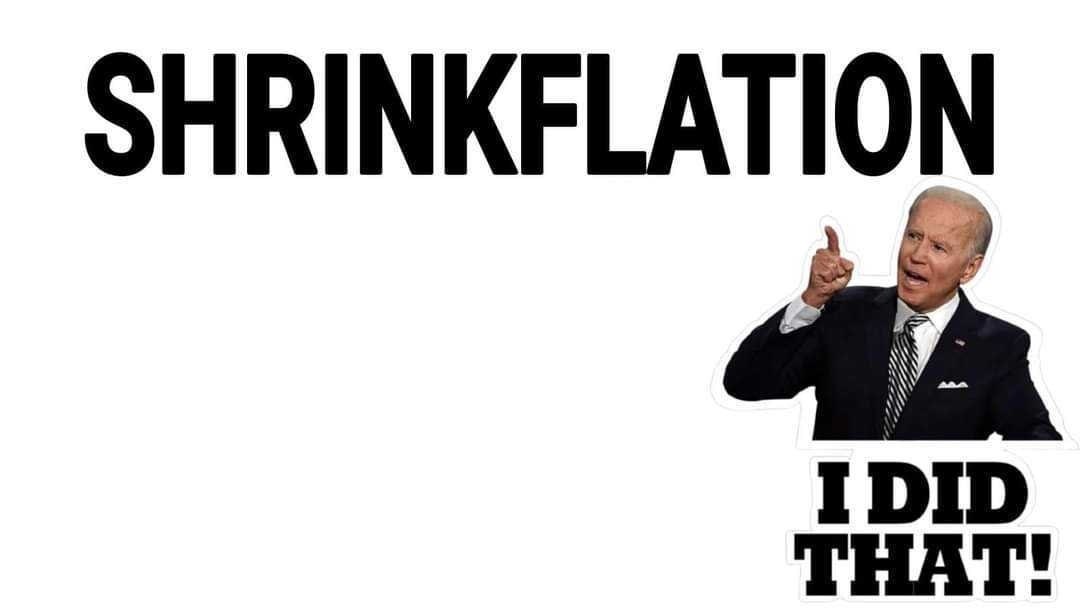During the Super Bowl, the president revealed his new economic scapegoat.
Did President Joe Biden just discover the concept of shrinkflation? If so, does he think it is a political liability for his re-election hopes? The White House believes so, leading the Democratic incumbent to deliver a Super Bowl Sunday video message and tell Corporate America to stop shrinking product packages while keeping prices the same. This is another exhibit in the current administration’s tactic of blaming others for the inflationary mess permeating the US marketplace.
Old Man Yelling at Clouds
Instead of participating in a 20-minute interview in front of one of the largest television audiences of the year, Biden chose to share a pre-recorded message depicting an old man yelling at the clouds. Or, in this case, an “elderly man with a poor memory” talk about frozen desserts and snacks. The 48-second clip consisted of the president complaining about sports drink bottles getting smaller, bags of chips containing fewer chips, and ice cream cartons shrinking in size. He added:
“I’ve had enough of what they call shrinkflation. It’s a rip-off. Some companies are trying to pull a fast one by shrinking the products little by little and hoping you won’t notice. Give me a break. The American public is tired of being played for suckers. I’m calling on companies to put a stop to this. Let’s make sure businesses do the right thing now.”

The administration clearly thinks it has latched on to something that would persuade households to support the president, scapegoating someone else for inflation (shock!). All over X, White House officials have been lamenting shrinkflation as if they just had made the discovery of the ages. However, like everything else, Biden and all the president’s men are behind the times as consumers have noticed this trend for a long time.
Shrinkflation Nothing New
Across the pond, there were more than 2,500 examples of shrinkflation between 2012 and 2017, according to the UK’s Office of National Statistics. Biden is not exaggerating, but shrinkflation is not new. Big brands have engaged in the stealth price inflation mechanism for a long time. Mouse Print is a website that tracks various consumer goods manufacturers have shrunk to refrain from boosting the price tag. Over the last year, Huggies reduced the number of baby wipes from 768 to 704. Downy concentrated its fabric softener by seven ounces, though users still receive 60 wash loads. The Folgers breakfast blend package shed nearly three ounces. Pepperidge Farm remembers when a bag of Goldfish contained 30 ounces of the baked snack crackers, but now it has 27.3 ounces.
 This is not the only way food companies grapple with inflationary pressures. You can also skim through the nutrition content label and observe some changes. A frozen meal might have fewer grams of protein. Nutella bolstered its skimmed milk powder and sugar content while reducing the amount of cocoa (the bean is trading at an all-time high on the futures market).
This is not the only way food companies grapple with inflationary pressures. You can also skim through the nutrition content label and observe some changes. A frozen meal might have fewer grams of protein. Nutella bolstered its skimmed milk powder and sugar content while reducing the amount of cocoa (the bean is trading at an all-time high on the futures market).
So, why do the major brands participate in this type of behavior? Academic, consumer, and industry studies have typically found that shoppers prefer shrinking sizes to price hikes.
The issue is that government statisticians have done a poor job quantifying inflation’s ugly cousin in the consumer price index (CPI) or the personal consumption expenditure (PCE) price index, particularly since the coronavirus pandemic. As a result, the on-the-ground experience is vastly different from what the Bureau of Economic Analysis or the Bureau of Labor Statistics reports in the monthly and quarterly data. However, based on the numbers inside the PCE, households are paying a lot more for food than before the pandemic.
Thinking beyond the checkout counter is hard, but everyone is contending with price pressures. Raw materials are higher, shipping is rocketing again, distribution is costlier, and labor and energy remain elevated. For budget-conscious or cash-strapped consumers, it comes down to two options: pay more for the same or pay the same for less.
Dollarflation
The most egregious example of shrinkflation is the US dollar. In theory, a buck is supposed to buy a buck’s worth of goods and services. In reality, a dollar purchases a nickel’s worth thanks to the Federal Reserve destroying 95% of the greenback’s value since its inception in 1913. If the well-meaning senior resident at 1600 Pennsylvania Ave. with an abysmal memory wants to howl at corporations to stay off his lawn, he would be better served shrieking at the Eccles Building (home of the Federal Reserve) for printing as much money as the nonsensical words found in Biden’s speeches.

